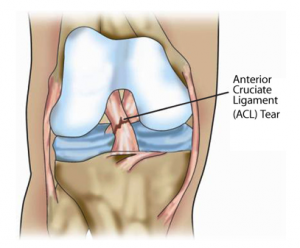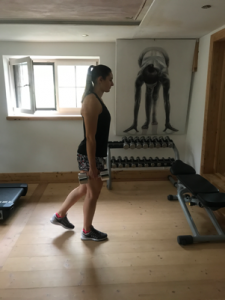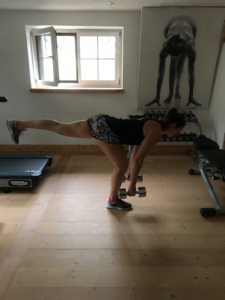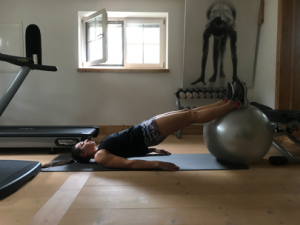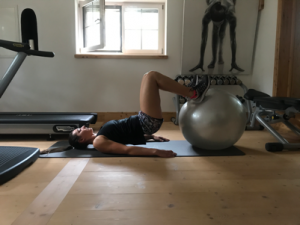Check out this article on ACL tears written by Lindsay Winninger for skiracing.com. I have worked with Lindsay throughout my rehab and she has played a huge part in getting me back to snow stronger than before! Read the article to learn some interesting facts about ski racing, ACL's, and exercises to help prevent injury.
--------------------------------------------------------------------------------
ACL Tears: Zoning In On Risk Factors
High speeds, crazy angles, unpredictable weather, and in your face course conditions make the sport of alpine ski racing an exciting but complex one. These unique factors can put the skier to the test in terms of their ability to absorb forces and velocities that not too many other activities can create. Having adequate strength, stability, and mobility to combat these forces is crucial. Injuries are abundant in ski racing and the knees especially take a heavy beating. The world of sports medicine is on an increasing trend of focusing heavily on injury prevention programs in efforts to reduce injury rates.
According to the FIS Injury Surveillance System, knee injuries account for more than 1/3 of all ski-related injuries. Of these knee injuries, the most commonly torn knee ligament is the anterior cruciate ligament, also known as the ACL. The ACL is one of 4 main ligaments in your knee. It is a strong band of tissue located inside your knee joint connecting your tibia (shin bone) and femur (thigh bone). The ACL is our body’s number one restraint for our tibia sliding forward on our femur. It also limits rotation between the two bones. The term ACL is not foreign to ski racers. I can bet every skier knows a teammate or of a fellow competitor that has undergone a surgery to repair this ligament. So how does it happen?
During an ACL injury, very often you will hear or feel a “pop” when this ligament tears. Swelling and instability are common and pain is dependent on the severity of the tear. There are several different mechanisms in which an ACL can tear. ACLs can rupture from hyperextension of the knee itself, landing incorrectly on a flexed knee, accelerating or decelerating with poor mechanics, twisting or rotating over a planted foot, a direct blow to the knee from improper contact or crash, or a sudden change in direction such as a cutting during an agility drill. As you can see the ACL can tear from numerous reasons and some are out of our control. But what about the things we can control?
There are 4 areas according to the latest research in orthopedics and sports medicine that have been identified as risk factors for ACL injuries or risk factors in the re-tearing of a surgically repaired ACL. They are:
- Leg Dominance
- Low Quadriceps to Hamstring ratio
- Trunk Dysfunction
- Hip Muscular Imbalance
Leg Dominance
Favoring one leg over another. We all have a leg we normally kick or drive with but are you actually using that leg more than the other in the gym or when skiing? Making sure symmetries exist side to side with muscle flexibility and strength is essential. Find a way to measure and compare.
TIP: Females tend to be more one leg dominant than men.
Quadriceps to Hamstring Ratio
Our muscles on the front (quadriceps) and back (hamstring) of our thigh work together to stabilize the knee joint. Both have a different function at the knee. The quadriceps work to straighten the knee and our hamstrings work to bend the knee and extend the hip. Both muscles need to be strong and work together to adequately support the knee joint and prevent unnecessary forces between the bones. Being excessively stronger in one muscle group can result in abnormal forces and extra stress on the knee ligaments, including the ACL.
TIP: Skiers tend to be quad dominant. Don’t forget the hamstrings! The hamstrings work at both the knee and the hip. Because this muscle performs two functions, it is very important to train your hamstrings for both of its functions (see pictures below).
Trunk Dysfunction
The inability to control your upper trunk in space. This is most commonly seen in core stability work, balance training, and jumping/landing. Can you control your center of mass during activity? If you can’t and you shift or change your movement pattern to compensate, how does that affect the forces on different areas of your body? Do you shift and wobble a lot? Do you use the correct muscles to stabilize your hips and back?
TIP: Master simple movements first and move to more complex work. Too often we see skiers doing advanced core and balance work and not using the correct muscles groups to perform the task at hand.
Hip Muscular Imbalance
Wait, the hip? Yes! If our hip is not strong enough to take on some of the reaction forces we encounter when skiing the forces will dissipate to the joint either above (back) or below (knee). Making sure the muscles that surround our hip joint are strong will prevent extra unnecessary force at our knee joint and ultimately on our ligaments too. Our butt muscles, the glutes, are the priority here.
TIP: Ski racers tend to be weak in the gluteus medius, also known as the hip abductors.
Identifying deficits in strength, stability, and mobility within these areas and creating a plan to address those deficits is crucial. Zoning in and addressing these risk factors will aid in having a well-balanced body for optimal performance and safety on the slopes.
Single Leg Romanian Deadlift
Above, Canadian Ski Racer Ali Nullmeyer properly performs a Single Leg Romanian Deadlift targeting her hamstrings. Our hamstrings serve 2 functions. The first is to extend our hip. This exercise addresses hamstring function at your hip joint.
Swiss Ball Curl
Above, Ali Nullmeyer performs a Swiss Ball Curl targeting her hamstrings. Our hamstrings second function is to flex the knee. This exercise addresses hamstring function at the knee joint. Training both functions of our hamstrings is essential.
The sport of alpine ski racing is considered a high-risk sport. But can some of these risks be decreased? While there will always be internal and external factors that can not be eliminated, by paying attention to leg dominance, quadricep to hamstring ratio, trunk dysfunction, and hip muscular imbalances research does suggest that it is possible to reduce the incidence of injuries at the knee, including a reduction of ACL tears. Zone in on deficits, create a plan and execute. Good luck!

